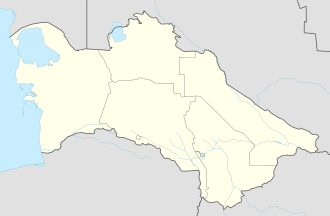Anau
Änew | |
|---|---|
 Ruins of Seýit Jemaladdin Mosque near Anau | |
| Coordinates: 37°53′N 58°32′E / 37.883°N 58.533°E | |
| Country | |
| Province | Ahal Province |
| District | Ak bugdaý District |
| Population (1989 census)[1] | |
• Total | 30,000 |

Anau (Turkmen: Änew, Russian: Аннау, romanized: Annau) is a city in Turkmenistan. Until 20 December 2022 it was the capital of Ahal Province.[2] The area has been inhabited since around 5500 BC. Prehistoric sites in Anau were discovered in excavations were conducted by Raphael Pumpelly and William Morris Davis in 1904.
Etymology
[edit]Anau is the Persian word for "new water".[3]
Geography
[edit]Anau is located in the foothills of the Kopet Dag mountain range.[4] It is 8 kilometers (5.0 mi) to the south of Ashgabat.[3]
History
[edit]The Chalcolithic Anau culture inhabited the area.[5] Inhabitation in Anau started in its northern area around 5500 BC. This settlement continued until 3000 BC when it moved to the south. This southern location was inhabited from 3000 to 1000 BC.[6]
Anau was given city status on 3 February 2008.[7] The city was designated "Cultural Capital of the Turkic World" for 2024 at the 39th session of the Permanent Council of Ministers of Culture of TURKSOY.[8][9]
Archaeology
[edit]
A Russian general explored mounds in the area in 1866, as he believed there was treasure within them.[3] Raphael Pumpelly and William Morris Davis conducted an excavation at Anau in 1904.[10] Hubert Schmidt and Wilhelm Dörpfeld supervised the digging for Pumpelly's excavation.[11] This excavation discovered a prehistoric settlement in Anau.[12] Pumpelly conducted another excavation in 1908.[6] Frank T. Hiebert conducted an excavation of the site in 1993.[13]
Charcoal was abundant in the area between 4500 and 1000 BC.[4] 85-90% of the cereal remains identified in ancient Anau were barley.[14]
References
[edit]- ^ Population census 2017 Archived 2012-01-18 at the Wayback Machine, Demoscope Weekly, No. 359-360, 1–18 January 2009 (search for Туркменская ССР) (in Russian)
- ^ "Постановление Меджлиса Милли Генгеша Туркменистана об отнесении к категории города нового современного административного центра Ахалского велаята и присвоении ему наименования" (in Russian). Электронная газета «Золотой век». 21 December 2022.
- ^ a b c Rapp 2015, p. 27.
- ^ a b Miller 1999, p. 14.
- ^ Hiebert 2002, p. 33.
- ^ a b Good 2012, p. 115.
- ^ Официальная хроника: Халк Маслахаты Туркменистана принял Постановление об изменении статуса некоторых городов и поселков Туркменистана 2008.
- ^ "Änew şäheri – türki dünýäsiniň medeni paýtagty boldy". TÜRKMENISTAN WE DÜNÝÄ HABARLARY (in Turkmen). 5 November 2022.
- ^ Nyýazmämedow, Çerkez (26 December 2022). "Новый облик древнего города" (in Russian). Нейтральный туркменистан. Archived from the original on 27 December 2022. Retrieved 27 December 2022.
- ^ Rapp 2015, p. 28.
- ^ Rapp 2015, p. 29.
- ^ Hiebert 2002, p. 27.
- ^ Rapp 2015, p. 34.
- ^ Miller 1999, p. 16.
Works cited
[edit]Books
[edit]- Lachenal, Guillaume (2022). The Doctor Who Would Be King. Duke University Press. ISBN 9781478015246.
Journals
[edit]- Good, Irene (2012). "Changes in Fiber Use and Spinning Technologies on the Iranian Plateau: a comparative and diachronic study of spindle whorls ca 4500-2500 BCE". Paléorient. 38 (1). CNRS Éditions: 111–126. doi:10.2307/43264566. JSTOR 43264566.
- Hiebert, Fredrik (2002). "The Kopet Dag Sequence of Early Villages in Central Asia". Paléorient. 28 (2). CNRS Éditions: 25–41. doi:10.2307/41496945. JSTOR 41496945.
- Miller, Naomi (1999). "Agricultural development in western Central Asia in the Chalcolithic and Bronze Ages". Vegetation History and Archaeobotany. 8 (1). Springer Nature: 13–19. doi:10.2307/23417637. JSTOR 23417637.
- Rapp, George (2015). "Raphael Pumpelly (1837-1923): Pioneering Archaeological Geologist in Central Asia". Earth Sciences History. 34 (1). History of Earth Sciences Society: 13–19. doi:10.2307/44075671. JSTOR 44075671.
Web
[edit]- "Официальная хроника: Халк Маслахаты Туркменистана принял Постановление об изменении статуса некоторых городов и поселков Туркменистана". Turkmenistan. 3 February 2008. Archived from the original on 7 January 2009.
External links
[edit]- ANAW (Anau) iranicaonline.org
